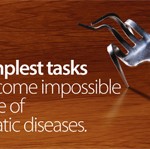However, when I walked into the room of the first patient visit of the day, as the fellow and I discussed the next steps in the management of one of our familiar and regular rheumatoid arthritis patients, the patient asked, “What are those bent forks on your lapels for?” We both looked at each other, and clearly neither of us had a pat or readily polished exam-room pitch. We took turns, answering that it was for the ACR, it was a public awareness campaign, and that the fork symbolized the difficulties and deformities of rheumatic diseases, experiences of people like her. She smiled in a way that only someone with 20 years experience of living with rheumatoid arthritis could. She had a question: “Where can I find out more?” Luckily, my sharp fellow had already clicked on the ACR home page and was navigating to the Simple Tasks website that explains the campaign.
This continued through that day and each day since. I’m no longer caught off guard, and have refined my responses. I’m even developing a menu of responses, from a 15-second “Go to SimpleTasks.org” for the quick elevator pitch, to a more nuanced and detailed discussion of rheumatic diseases, their impact, and the mission of the ACR for a potential donor. And, as I do when preparing to lecture on musculoskeletal pathophysiology to the second-year medical students, I researched the source material at the Simple Tasks Campaign website.
In considering the bent forks we are wearing, we have an opportunity to tell the story of the personal toll, the diseases, the numbers, the window of opportunity, and why rheumatology is the solution. These are the cornerstones of the Simple Tasks Campaign. As people encounter our bent forks and ask us about them, we have the opportunity to reveal who we are and what we do. We have the opportunity to educate the public about the value of rheumatology.
So when you use that fascinating piece of technology, the fork, think of what it would be if bent. I urge all of you to wear it on you lapels. Then, be prepared to answer the question, “What is that bent fork for?” I’d love to hear what you all have to say.
Calvin R. Brown Jr., M.D.
Professor of Medicine and Training Program Director Division of Rheumatology
Northwestern University Feinberg
School of Medicine
Chicago
